CAUSES OF ATOPIC DERMATITIS AND MEASURES FOR ITS PREVENTION
Abstract
Atopic dermatitis (AD) is a chronic inflammatory, itching skin with a significant psychosocial impact on patients and relatives. In adults and adolescents besides flexural eczema, head and neck eczema, and hand eczema, which are the most frequent clinical phenotypes (84.9% and 84.2%, respectively), there are also other possible presentation such as, portrait-like dermatitis (20.1%), diffuse eczema (6.5%), eczema nummulare-like (5.8%), prurigo nodularis-like (2.1%) and erythrodermia (0.7%). Diagnosis can be easy due to the typically distributed eczematous lesions, albeit with agerelated differences, However, it is also extremely heterogeneous in severity, course, and sometimes particular clinical features. Currently, there are no better diagnostic criteria than an experienced dermatologist for the diagnosis of AD. Misdiagnosis and delayed treatment will have an impact not only on the child's physical health, but also and especially on the child's psychological health. The aim of our review was to group the main differential diagnoses in pediatric age where the diagnosis can often hide many pitfalls.
References
1. Langan SM, Irvine AD, Weidinger S. Atopic dermatitis [published correction appears in Lancet. 2020 Sep 12;396(10253):758]. Lancet. 2020;396(10247):345-360.
2. Strathie Page S, Weston S, Loh R. Atopic dermatitis in children. Aust Fam Physician. 2016 May;45(5):293-296.
3. Nutten S. Atopic dermatitis: global epidemiology and risk factors. Ann Nutr Metab. 2015;66(Suppl 1):8-16
4. Silverberg JI, Vakharia PP, Chopra R, et al. Phenotypical differences of childhood- and adult-onset atopic dermatitis. J Allergy Clin Immunol Pract. 2018;6(4):1306-1312.
5. Kwon IH, Won CH, Lee DH, et al. The prevalence and risk factors of atopic dermatitis and clinical characteristics according to disease onset in 19-year-old Korean male subjects. Ann Dermatol. 2018;30(1): 20-28.
6. Girolomoni G, de Bruin-Weller M, Aoki V, et al. Nomenclature and clinical phenotypes of atopic dermatitis. Ther Adv Chronic Dis. 2021; 12: 20406223211002979.
7. Odhiambo JA, Williams HC, Clayton TO, Robertson CF, Asher MI, ISAAC Phase Three Study Group. Global variations in prevalence of eczema symptoms in children from ISAAC phase three. J Allergy Clin Immunol. 2009;124(6):1251-1258. e23.
8. Mallol J, Crane J, von Mutius E, et al. The international study of asthma and allergies in childhood (ISAAC) phase three: a global synthesis. Allergol Immunopathol (Madr). 2013;41(2):73-85.
9. Williams H, Stewart A, von Mutius E, Cookson W, Anderson HR. International study of asthma and allergies in childhood (ISAAC) phase one and three study groups. Is eczema really on the increase worldwide? J Allergy Clin Immunol. 2008;121(4):947-954. e15.
10. David Boothe W, Tarbox JA, Tarbox MB. Atopic dermatitis: pathophysiology. Adv Exp Med Biol. 2017;1027:21-37.
11. Løset M, Brown SJ, Saunes M, Hveem K. Genetics of atopic dermatitis: from DNA sequence to clinical relevance. Dermatology. 2019; 235(5):355-364.
12. Torres T, Ferreira EO, Gonçalo M, Mendes-Bastos P, Selores M, Filipe P. Update on atopic dermatitis. Acta Med Port. 2019;32(9): 606-613.
13. Apfelbacher CJ, Diepgen TL, Schmitt J. Determinants of eczema: population-based cross-sectional study in Germany. Allergy. 2011; 66(2):206-213.
14. Paternoster L, Standl M, Waage J, et al. Multi-ancestry genome-wide association study of 21,000 cases and 95,000 controls identifies new risk loci for atopic dermatitis. Nat Genet. 2015;47(12):1449-1456.
15. South AP, Cabral A, Ives JH, et al. Human epidermal differentiation complex in a single 2.5 Mbp long continuum of overlapping DNA cloned in bacteria integrating physical and transcript maps. J Invest Dermatol. 1999;112(6):910-918.
16. Silverberg NB, Silverberg JI. Inside out or outside in: does atopic dermatitis disrupt barrier function or does disruption of barrier function trigger atopic dermatitis? Cutis. 2015;96(6):359-361.
17. Mirraximova M. X. et al. Night of atopic dermatitis in children komorbid laboratory-immunological properties //IMRAS. – 2023. – Т. 6. – №. 6. – С. 301-306.
18. Kh M. M., Kurbanova D. R., Nishanbaeva N. Y. Identification of clinical and laboratory changes of the gastrointestinal tract in atopic dermatitis in children and improvement of the principles of diagnosis and treatment/ISSN 2181-712X.






















